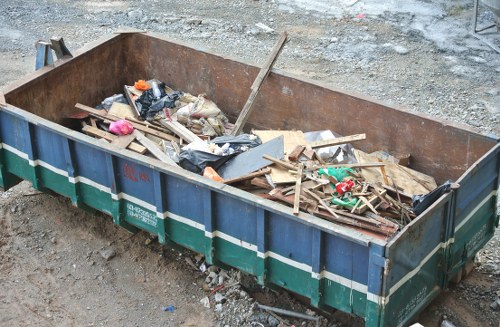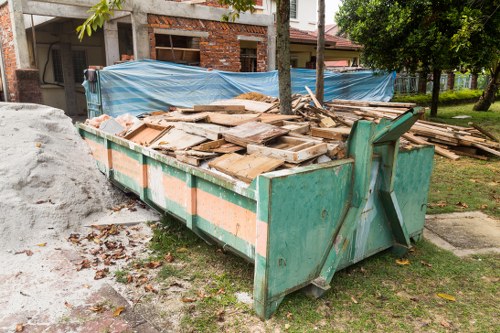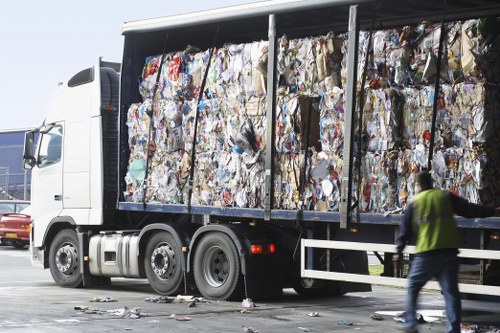Waste Clearance in Furniture Disposal

Proper waste clearance is essential for maintaining a clean and healthy environment. When it comes to furniture disposal, the process can be both challenging and daunting. Whether you're moving, renovating, or simply decluttering, understanding the best practices for furniture disposal ensures that waste is managed responsibly and sustainably.
Furniture items often contain materials that are not only bulky but also potentially hazardous if not disposed of correctly. From wooden frames to metal components and synthetic fabrics, each piece requires specific handling to minimize environmental impact. This article delves into the various aspects of waste clearance in furniture disposal, providing you with comprehensive insights and actionable steps.
In the following sections, we'll explore different methods of furniture disposal, the importance of recycling, the role of professional services, and tips for minimizing waste. By the end of this guide, you'll be equipped with the knowledge to make informed decisions about how to dispose of your old furniture responsibly.
Understanding Furniture Waste Clearance

Furniture waste clearance involves the systematic process of removing and disposing of unwanted furniture items. This process is crucial not only for freeing up space in your home or office but also for ensuring that waste is handled in an environmentally friendly manner.
There are several reasons why effective furniture disposal is important. Firstly, it helps in reducing clutter, making your living or working space more organized and aesthetically pleasing. Secondly, it prevents the accumulation of waste that can have detrimental effects on the environment. Finally, responsible disposal can also save you money by potentially recovering value from recyclable materials.
Before diving into the disposal methods, it's important to assess the condition of your furniture. Items that are still in good condition can be donated or resold, while those that are damaged or outdated may need to be disposed of through other means. Understanding the value and recyclability of your furniture can significantly impact how you approach waste clearance.
Types of Furniture Waste

Furniture waste can be categorized into several types, each requiring different disposal methods. The main categories include:
- Wooden Furniture: Items like tables, chairs, and cabinets made primarily of wood.
- Metal Furniture: Pieces that incorporate metal components, such as steel or aluminum frames.
- Synthetic and Upholstered Furniture: Including sofas, mattresses, and chairs with fabric coverings.
- Mixed Materials: Furniture that combines multiple materials, making recycling more complex.
Identifying the type of furniture waste you have is the first step in determining the most effective disposal method.
Methods of Furniture Disposal

There are several methods available for furniture disposal, each with its own set of benefits and considerations. The choice of method often depends on the condition of the furniture, your budget, and environmental considerations.
1. Donation: If your furniture is still in good condition, donating it to charity can be a great option. Many organizations accept used furniture, providing it to those in need while keeping it out of landfills.
2. Resale: Selling your furniture through online marketplaces or local thrift stores can help you recoup some of your investment and ensure the item is reused.
Recycling

Recycling is an environmentally responsible method of furniture disposal. By breaking down furniture into its constituent materials, recycling reduces the demand for new raw materials and minimizes waste.
Different materials require specific recycling processes. For example, wood can be reclaimed and used in new products, while metal parts can be melted down and repurposed. However, recycling upholstered furniture can be more challenging due to the combination of materials used.
It's essential to locate recycling centers that accept furniture and understand their guidelines. Some municipalities offer specialized recycling programs for large items like furniture, making the process more accessible.
Professional Furniture Disposal Services

When dealing with large quantities of furniture or particularly cumbersome items, professional disposal services can be invaluable. These services handle the heavy lifting, transportation, and proper disposal of your furniture, ensuring compliance with local regulations.
Professional services often offer additional benefits such as:
- Convenience: Eliminating the need for you to transport heavy items.
- Efficiency: Quick and organized clearance, saving you time.
- Compliance: Ensuring that disposal methods meet environmental standards.
When selecting a disposal service, consider factors like cost, reputation, and the range of services offered. Reading reviews and comparing quotes can help you make an informed decision.
Green Disposal Solutions

Green disposal solutions focus on minimizing environmental impact through sustainable practices. This can include recycling, upcycling, and composting where applicable.
Upcycling involves transforming old furniture into something new and useful, extending the life of the materials and reducing waste. For example, an old dresser can be repainted and used as a bookshelf.
Composting is less common for furniture but can be applicable for natural materials like wood. Breaking down biodegradable components contributes to soil health and reduces landfill reliance.
Regulations and Guidelines

Disposing of furniture is subject to various local regulations and guidelines aimed at protecting the environment and public health. Understanding these rules is essential to ensure compliance and avoid potential fines.
Common regulations include:
- Extended Producer Responsibility (EPR): Manufacturers may be required to take back products at the end of their lifecycle.
- Landfill Bans: Prohibiting certain types of waste, including electronics or hazardous materials, from being disposed of in landfills.
- Recycling Mandates: Requiring a percentage of materials to be recycled or reused.
It's advisable to check with your local waste management authority to understand the specific rules applicable to furniture disposal in your area.
Permits and Licensing

In some regions, disposing of large quantities of furniture may require permits or licensing, especially if the disposal involves commercial activities or hazardous materials.
For individuals, permits might be necessary for bulk item disposal or if you're disposing of items that contain chemicals or other regulated substances.
Professional disposal services typically handle the necessary permits and ensure that all disposal activities are legal and compliant. If you're undertaking disposal independently, make sure to obtain any required documentation to avoid legal complications.
Cost Considerations

The cost of furniture disposal can vary widely based on several factors, including the type and quantity of furniture, the disposal method chosen, and your geographic location.
Some cost considerations include:
- Pickup Fees: Charges for collecting large or bulky items from your location.
- Recycling Fees: Costs associated with processing and recycling certain materials.
- Donation Handling: Some charities offer free pickup services, while others may charge a fee.
- Transportation Costs: Expenses related to moving furniture to disposal or recycling centers.
Comparing different disposal options and obtaining multiple quotes can help you find the most cost-effective solution for your needs.
Budget-Friendly Disposal Options
If you're looking to dispose of furniture without breaking the bank, consider the following budget-friendly options:
- Donation: As mentioned earlier, donating to charities can often be done for free and provides tax benefits.
- Sell or Give Away: Using online platforms to sell or give away furniture can save you disposal fees.
- DIY Disposal: Renting a dumpster or using your vehicle to transport items to a landfill or recycling center can be cost-effective for small quantities.
Being resourceful and exploring multiple avenues can significantly reduce the costs associated with furniture disposal.
Minimizing Waste in Furniture Disposal
Minimizing waste is a crucial aspect of sustainable living. When disposing of furniture, adopting strategies that reduce the amount of waste generated can have a positive environmental impact.
Some effective waste-minimizing strategies include:
- Repair and Refurbish: Fixing broken parts or updating the appearance of furniture can extend its lifespan and delay the need for disposal.
- Upcycling: Transforming old furniture into new and functional items adds value and reduces waste.
- Selective Disposal: Dispose only of items that are beyond repair or no longer useful, keeping as much of the original material as possible.
By implementing these strategies, you contribute to a circular economy where materials are reused and recycled, lessening the burden on landfills and conserving natural resources.
Eco-Friendly Disposal Practices
Eco-friendly disposal practices focus on reducing environmental harm through conscious actions and choices. These practices not only benefit the planet but also promote sustainable living.
Key eco-friendly practices include:
- Choose Green Disposal Services: Opt for services that prioritize recycling and sustainable methods.
- Separate Materials: Disassemble furniture and separate different materials to facilitate recycling.
- Avoid Landfills: Whenever possible, choose recycling or donation over landfill disposal to minimize environmental impact.
Adopting eco-friendly practices ensures that your furniture disposal aligns with broader environmental goals and contributes to a healthier planet.
Impact of Improper Disposal
Improper furniture disposal can have severe consequences for the environment and public health. Landfills, where much of the improperly disposed furniture ends up, are major sources of pollution and greenhouse gas emissions.
Key impacts of improper disposal include:
- Environmental Contamination: Chemicals, paints, and other hazardous materials from furniture can leach into soil and water.
- Resource Waste: Valuable materials are lost when furniture is not recycled or reused, leading to increased demand for raw materials.
- Health Hazards: Decomposing furniture can attract pests and contribute to unsanitary conditions.
Understanding these impacts underscores the importance of responsible furniture disposal and encourages the adoption of sustainable practices.
Legal Repercussions
Failing to comply with local disposal regulations can result in legal repercussions, including fines and penalties. It's essential to adhere to the laws governing furniture disposal to avoid these consequences.
In some cases, improper disposal can lead to more severe legal issues, especially if it results in environmental damage or health hazards. Ensuring that you follow the correct procedures protects you and the community.
Always consult local waste management authorities or professional services to ensure that your furniture disposal is legal and compliant with all relevant regulations.
Technology and Innovations in Furniture Disposal
Advancements in technology have significantly improved the efficiency and sustainability of furniture disposal. Innovations in recycling technologies, waste management software, and material science are transforming how we handle waste.
Examples of technological advancements include:
- Automated Sorting Systems: These systems use AI and robotics to sort materials more accurately and efficiently.
- Biodegradable Materials: Development of furniture materials that break down naturally reduces the environmental impact.
- Waste Management Software: Platforms that streamline the disposal process, from scheduling pickups to tracking recycling efforts.
These innovations make furniture disposal more accessible, efficient, and environmentally friendly, contributing to smarter waste management practices.
Future Trends
The future of furniture disposal is likely to be shaped by ongoing innovations and a growing emphasis on sustainability. Potential trends include:
- Circular Economy Models: Systems that promote the reuse, refurbishment, and recycling of materials to minimize waste.
- Smart Disposal Solutions: Integration of IoT devices to monitor and manage waste in real-time.
- Increased Consumer Awareness: Growing public consciousness about the environmental impact of waste will drive demand for responsible disposal options.
Staying informed about these trends can help individuals and businesses adapt to more sustainable furniture disposal practices in the future.
Tips for Effective Furniture Disposal
Disposing of furniture effectively requires careful planning and consideration. Here are some practical tips to help you manage the process smoothly:
- Plan Ahead: Schedule disposal well in advance to ensure that services are available and that you have adequate time to prepare the items.
- Measure Your Space: Ensure that larger pieces of furniture can fit through doorways, hallways, and staircases to prevent damage during transport.
- Disassemble When Possible: Breaking down furniture into smaller parts can make transportation easier and reduce disposal costs.
- Protect Against Damage: Use padding or wrapping materials to protect furniture from scratches, dents, and other damage during handling.
- Sort Items: Separate items based on their condition and material to streamline the disposal process.
Implementing these tips can make furniture disposal more efficient and less stressful.
Safety Considerations
Safety should always be a priority when disposing of furniture. Improper handling can lead to injuries and accidents. Here are some safety considerations:
- Use Proper Lifting Techniques: Avoid back injuries by using your legs to lift heavy items and seeking assistance if needed.
- Wear Protective Gear: Gloves, masks, and sturdy footwear can protect you from sharp edges, dust, and other hazards.
- Secure Items During Transport: Ensure that furniture is securely fastened to prevent shifting and potential accidents during transportation.
- Beware of Hazardous Materials: Some furniture may contain chemicals, paints, or other hazardous substances. Handle these items with care and dispose of them according to local regulations.
Adhering to these safety measures ensures that furniture disposal is conducted without harm to you or others.
Conclusion
Waste clearance in furniture disposal is a multifaceted process that requires thoughtful consideration and responsible action. By understanding the various disposal methods, adhering to regulations, and adopting sustainable practices, you can minimize environmental impact and manage your space effectively.
Whether you choose to donate, recycle, or seek professional services, the key is to make informed decisions that align with your values and the needs of your community.
Remember, every piece of furniture you dispose of responsibly contributes to a healthier planet and a more sustainable future.
Contact us today to learn more about sustainable furniture disposal solutions and how we can assist you in managing your waste efficiently and responsibly. Book your service now and take the first step towards a cleaner, greener environment.